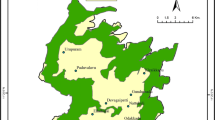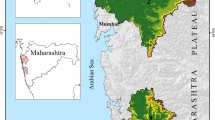Abstract
Lineaments are the linear or curvilinear geological surface features which reflect the tectonic history, groundwater potential, oil, and mineral resource availability of a given area. In view of the importance of lineaments, the present study is carried out to understand the spatial distribution, orientation, density, and the influence of lineaments on drainage network. The study focuses on the extraction of lineaments in Pravara basin, Maharashtra, by using Cartosat Digital Elevation Model (CartoDEM). The lineaments are extracted and analyzed in ArcGIS and Rockworks software, respectively. Comparative analysis is performed on eight different lineament outputs which are extracted from various azimuth angles to prepare one final lineament map of the study area. Total number of lineaments found in the study area is 709 with the length of 1194.77 km. The western part of the Pravara basin shows higher lineament density as compared to the central and eastern part. Therefore, these areas might be affected by higher structural deformation. Also, this area might have higher groundwater infiltration potential due to the higher density of lineaments as they work as the structural weaknesses and influence the water to infiltrate in sub-surface region. The study has shown that the predominant orientation of lineaments trending to NNW-SSE. About 10% of the total stream length is found to have the influence of lineaments on the drainage network. More control of lineaments is observed in the source region of the drainage, where mostly first-order streams are found. Apart from the significant findings, this study has been generated a detailed structural information over the study area and the output could be applied for future planning and management of the water resources, tectonic evolution, and in other fields of geosciences.











Similar content being viewed by others
References
Abdullah A, Akhir JM, Abdullah I (2010) Automatic mapping of lineaments using shaded relief images derived from digital elevation model (DEMs) in the Maran–Sungi Lemving area, Malaysia. EJGE 15:949–957
Arlegui LE, Soriano MA (1998) Characterizing lineaments from satellite images and field studies in the Central Ebro basin (NE Spain). Int J Remote Sens 19(16):3169–3185. https://doi.org/10.1080/014311698214244
Bondre NR, Dole G, Phadnis VM, Duraiswami RA, Kale VS (2000) Inflated pahoehoe lavas from the Sangamner area of the western Deccan Volcanic Province. Curr Sci 78:1004–1007
Bondre NR, Duraiswami RA, Dole G (2004) Morphology and emplacement of flows from the Deccan Volcanic Province. Bull Volcanol 66:29–45. https://doi.org/10.1007/s00445-003-0294-x
Bondre NR, Hart WK, Sheth HC (2006) Geology and geochemistry of the Sangamner mafic dike swarm, western Deccan volcanic province, India: implications for regional stratigraphy. J Geol 114:155–170. https://doi.org/10.1086/499568
CFCFF–Committee on Fracture Characterization and Fluid Flow (1996) Rock fractures and fluid flow: contemporary understanding and applications. National Academy Press, Washington
Chaabouni R, Bouaziz S, Peresson H, Wolfgang J (2012) Lineament analysis of south Jenein area (southern Tunisia) using remote sensing data and geographic information system. Egyptian J Remote Sen Space Sci 15:197–206. https://doi.org/10.1016/j.ejrs.2012.11.001
Chaminé HI (2015) Water resources meet sustainability: new trends in environmental hydrogeology and groundwater engineering. Envior Earth Sci 73(6):2513–2520
Chaminé HI, Carvalho JM, Afonso MJ, Teixeira J, Freitas L (2013) On a dialogue between hard-rock aquifer mapping and hydrogeological conceptual models: insights into groundwater exploration. Eur Geol J 35:26–31
Chaminé HI, Carvalho JM, Teixeira J, Freitas L (2015) Role of hydrogeological mapping in groundwater practice: back to basics. Eur Geol J 40:34–42
Chandrasekhar P, Martha TR, Venkateswarlu N, Subramanian SK, Kamaraju MVV (2011) Regional geological studies over parts of Deccan Syneclise using remote sensing and geophysical data for understanding hydrocarbon prospects. Curr Sci 100(1):95–99
Chang Y, Song G, HSU S (1998) Automatic extraction of ridge and valley axes using the profile recognition and polygon-breaking algorithm. Comput Geosci 24(1):83–93. https://doi.org/10.1016/S0098-3004(97)00078-2
Chenet A, Courtillot V, Fluteau F, Gerard M, Quidelleur X, Khadri SFR, Subbarao KV, Thordarson T (2009) Determination of rapid Deccan eruptions across the Cretaceous-Tertiary boundary using paleomagnetic secular variation: 2. Constrains from analysis of eight new sections and synthesis for a 3500-m-thick composite section. J Geophy Res 114:B06103. https://doi.org/10.1029/2008JB005644
Costa RD, Starkey J (2001) Photo Lin: a program to identify and analyze linear structures in aerial photographs, satellite images and maps. Comput Geosci 27(5):527–534
Das S (2017) Signatures of morphotectonic activities in western upland Maharashtra and Konkan region. Unpublished M.Sc. thesis submitted to Savitribai Phule Pune University
Das DP, Chakraborty DK, Sarkar K (2003) Significance of the regional lineament tectonics in the evolution of the Pranhita-Godavari sedimentary basin interpreted from the satellite data. J Asian Earth Sci 21:553–556. https://doi.org/10.1016/S1367-9120(02)00025-1
Das S, Pardeshi SD (2018) Comparative analysis of lineaments extracted from Cartosat, SRTM and ASTER DEM: a study based on four watersheds in Konkan region, India. Spat Inf Res 26(1):47–57. https://doi.org/10.1007/s41324-017-0155-x
Das S, Gupta A, Ghosh S (2017) Exploring groundwater potential zones using MIF technique in semi-arid region: a case study of Hingoli district, Maharashtra. Spat Inf Res 25(6):749–756. https://doi.org/10.1007/s41324-017-0144-0
Doke A, Pardeshi SD, Pardeshi SS, Das S (2018) Identification of morphogenetic regions and respective geomorphic processes: a GIS approach. Arab J Geosci 11:20. https://doi.org/10.1007/s12517-017-3358-5
Edet AE, Okereke CS, Teme SC, Esu EO (1998) Application of remotesensing data to groundwater exploration: a case study of the Cross River state. SE Nigeria. Hydrogeology J 6:394–404. https://doi.org/10.1007/s100400050162
Farina P, Catani F, Colombo D, Fumagalli A, Kukavicic M, Marks F, Moretti S (2005) Remote sensing: a tool for landslide investigations at a basin scale. Geophy Res Abs 7:10157–10168
Greenbaum D (1985) Review of remote sensing applications to groundwater exploration in basement and regolith, Brit. Geol. Surv. Rep. OD 85/8, pp. 18–36
Griffiths JS, Stokes M (2008) Engineering geomorphological input to ground models: an approach based on earth systems. Quart J Eng Geol Hydrol 41:73–91
Henderson D, Ferrill DA, Clarke KC (1996) Mapping geological faults using image processing techniques applied to hill-shaded digital elevation models: Proceedings of the IEEE Southwest Symposium on Image Analysis and Interpretation, p. 240–245, https://doi.org/10.1109/IAI.1996.493760
Hobbs WH (1903) Lineaments of the Atlantic border region. Geol Soc Am Bull 15:483–506. https://doi.org/10.1130/GSAB-15-483
Hobbs WH (1912) Earth features and their meaning. McMillan, New York
Hubbard BE, Mack TJ, Thompson AL (2012) Lineament analysis of mineral areas of interest in Afghanistan. US Geol Sur Open-File Report 2012–1048:28
Hung LQ, Dinh NQ, Batelaan O, Tam VT, Lagrou D (2002) Remote sensing and GIS-based analysis of cave development in the Suoimuoi catchment (son la - NW Vietnam). J Cave Karst Stud 64(1):23–33
Kanungo DP, Sarkar S, Mehrotra GS (1995) Statistical analysis and tectonic interpretation of the remotely sensed lineament fabric data associated with the North Almora thrust, Garhwal Himalaya, India. J Indian Soc Remote Sens 23(4):201–210. https://doi.org/10.1007/BF03024501
Karnieli A, Meisels A, Fisher L, Arkin Y (1996) Automatic extraction of geological linear features from digital remote sensing data using a Hough transform. Photogramm Eng Remote Sens 62:525–531
Khadri SFR; Subbarao K V; Hooper PR; Walsh JN (1988) Stratigraphy of Thakurvadi formation, western Deccan Basalt Province, India. In Subbarao KV (ed) Deccan flood basalts Geol Soc India Mem 10:281–304
Kiran Raj S, Ahmed SA (2014) Lineament extraction from southern Chitradurga Schist Belt using Landsat TM, ASTERGDEM and geomatics techniques. Int J of Comp App 93(12):12–20
Lattman LH (1958) Technique of mapping geological fracture and lineaments on aerial photographs. Photogrammetric Eng 19(4):568–576
Lattman LH, Parizek RR (1964) Relationship between fracture traces and the occurrence of ground water in carbonate rocks. J Hydrol 2:73–91. https://doi.org/10.1016/0022-1694(64)90019-8
Leech DP, Treloar PJ, Lucas NS, Grocott J (2003) Landsat TM analysis of fracture patterns: a case study from the coastal cordillera of northern Chile. Int J Remote Sens 24(19):3709–3726. https://doi.org/10.1080/0143116031000102520
Magowe M, Carr JR (1999) Relationship between lineaments and ground water occurrence in western Botswana. Ground Water 37(2):282–286. https://doi.org/10.1111/j.1745-6584.1999.tb00985.x
Majumdar TJ, Bhattacharya BB (1998) Application of the Haar transform forextraction of linear and anomalous over part of Cambay Basin, India. Int J Remote Sens 9(12):1937–1942. https://doi.org/10.1080/01431168808954992
Masoud A, Koike K (2011) Auto-detection and integration of tectonically significant lineaments from SRTM DEM and remotely-sensed geophysical data. ISPRS J Photogramm Remote Sens 66:818–832. https://doi.org/10.1016/j.isprsjprs.2011.08.003
Masoud A, Koike K (2017) Applicability of computer-aided comprehensive tool (LINDA: LINeament detection and analysis) and shaded digital elevation model for characterizing and interpreting morphotectonic features from lineaments. Comput Geosci 106:89–100. https://doi.org/10.1016/j.cageo.2017.06.006
Mostafa ME, Bishta AZ (2005) Significance of lineament patterns in rock unit classification and designation: a pilot study on the Gharib-Dara area, northern Eastern Desert, Egypt. Int J Remote Sens 26(7):1463–1475. https://doi.org/10.1080/01431160410001705088
Mostafa ME, Zakir FA (1996) New enhancement techniques for azimuthal analysis of lineaments for detecting tectonic trends in and around the afro-Arabian shield. Int J Remote Sens 17(15):2923–2943. https://doi.org/10.1080/01431169608949119
Muhammad MM, Awdal AH (2012) Automatic mapping of lineaments using shaded relief images derived from digital elevation model (DEM) in Erbil-Kurdistan, Northeast Iraq. Adv Nat Appl Sci 6(2):138–146
Nag SK (2005) Application of lineament density and hydrogeomorphology to delineate ground water potential zones of Baghmundi block of Purulia district, West Bengal. J Indian Soc Remote Sens 33(4):521–529. https://doi.org/10.1007/BF02990737
Nama EE (2004) Lineament detection on Mount Cameroon during the 1999 volcanic eruptions using Landsat ETM. Int J Remote Sens 25(3):501–510. https://doi.org/10.1080/0143116031000102557
O’Leary DW, Friedman JD, Pohn HA (1976) Lineament, linear, lineation: some proposed new standards for old terms. Geol Soc Am Bull 87:1463–1469. https://doi.org/10.1130/0016-7606(1976)87<1463:LLLSPN>2.0.CO;2
Oguchi T, Aoki T, Matsuta N (2003) Identification of an active fault in the Japanese alps from DEM-based hill shading. Comput Geosci 29:885–891
Qari MYHT (1991) Application of Landsat TM data to geological studies, Al-Khabt area, southern Arabian shield. Photogramm Eng Remote Sensing 57(4):421–429
Qari MYHT, Şen Z (1994) Remotely sensed fracture patterns in southwestern Saudi Arabia and qualitative analysis. Bull Int Assoc Eng Geol 49:63–72. https://doi.org/10.1007/BF02595002
Raj NJ, Prabhakaran A, Muthukrishnan A (2017) Extraction and analysis of geological lineaments of Kolli hills, Tamil Nadu: a study using remote sensing and GIS. Arab J Geosci 10:195. https://doi.org/10.1007/s12517-017-2966-4
Sabins FF (1996) Remote sensing: principles and interpretation, 3rd edn. W. H. Freeman and company, New York 494p
Saraf AK, Das JD, Agarwal B, Sundaram RM (1996) False topography perception phenomena and its correction. Int J Remote Sens 17:3725–3733
Saraf AK, Mohammed Z, Das J, Sharma K, Rawat V (2011) False topographic perception phenomena observed with the satellite images of Moon’s surface. Int J Remote Sens 32:9869–9877
Şengör AMC (2014) How scientometry is killing science. GSA Today 24(12):44–45
Spencer EW (1988) Introduction to the structure of the earth. Mc Graw Hill Inc., 551p
Strahler AN (1952) Dynamics basis of geomorphology. Bull Geol Soc Am 63:923–938. https://doi.org/10.1130/0016-7606(1952)63[923,DBOG]2.0.CO;2
Subbarao KV, Hooper PR (1988) Reconnaissance map of the Deccan Basalt Group in the Western Ghats, India. In Subbarao KV (ed.) Deccan Flood Basalts. Geol. Soc. India Mem. 10 (enclosure)
Suzen ML, Toprak V (1998) Filtering of satellite images in geological lineament analyses: an application to a fault zone in Central Turkey. Int J Remote Sens 19(6):1101–1114. https://doi.org/10.1080/014311698215621
Tahir AG, Garba ML, Hassan C (2015) Lineaments analysis to identify favourable areas for groundwater in Kano City northwestern Nigeria. J Environ Earth Sci 5(2):1–7
Teixeira J, Chaminé HI, Carvalho JM, Pérez-Alberti A, Rocha F (2013) Hydrogeomorphological mapping as a tool in groundwater exploration. J Maps 9(2):263–273
Wallace SR (1975) The Henderson ore body-elements of discovery: reflections. Min Eng 27(6):34–36
Wheeler R (1983) Linemanship and the practice of linear geo-art. Geol Soc Am Bull 94:1377–1378
Zakir FA, Qari MHT, Mostafa ME (1999) A new optimizing technique for preparing lineament density maps. Int J Remote Sens 20(6):1073–1085. https://doi.org/10.1080/014311699212858
Zlatopolsky AA (1992) Program LESSA (lineament extraction and stripe statistical analysis) automated linear image features analysis experimental results. Comput Geosci 18(9):1121–1126. https://doi.org/10.1016/0098-3004(92)90036-Q
Zlatopolsky AA (1997) Description of texture orientation in remote sensing data using computer program LESSA. Comput Geosci 23(1):45–62. https://doi.org/10.1016/S0098-3004(96)00053-2
Acknowledgements
The corresponding author wishes to thank Dr. Abdullah M. Al-Amri (editor-in-chief, Arabian Journal of Geosciences) and the handling editor for their valuable comments and suggestions on this manuscript. The authors are grateful to three anonymous reviewers for their critical and constructive comments which improved the content significantly.
Author information
Authors and Affiliations
Corresponding author
Rights and permissions
About this article
Cite this article
Das, S., Pardeshi, S.D., Kulkarni, P.P. et al. Extraction of lineaments from different azimuth angles using geospatial techniques: a case study of Pravara basin, Maharashtra, India. Arab J Geosci 11, 160 (2018). https://doi.org/10.1007/s12517-018-3522-6
Received:
Accepted:
Published:
DOI: https://doi.org/10.1007/s12517-018-3522-6




